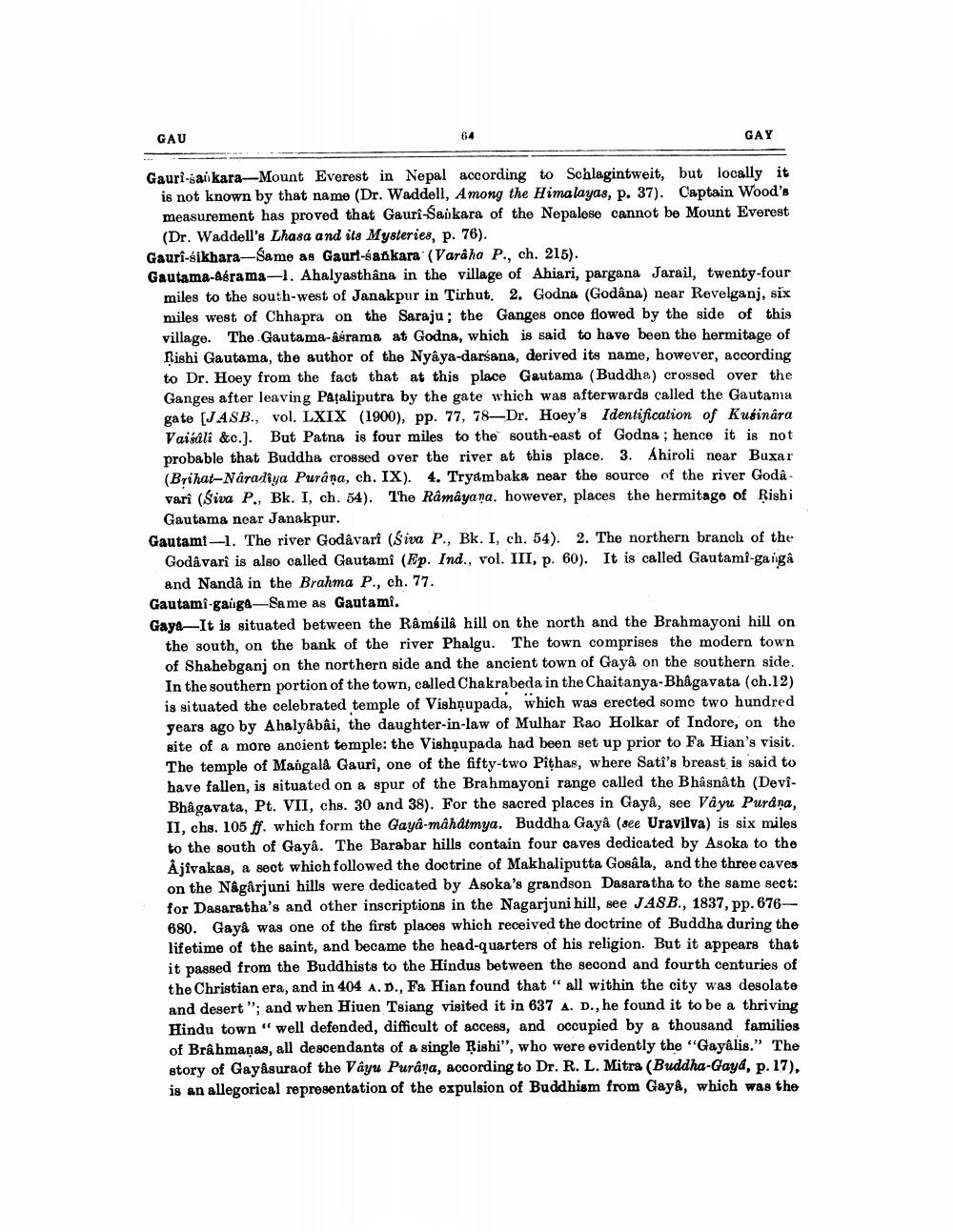________________
GAU
GAY
Gauri-saikara-Mount Everest in Nepal according to Schlagintweit, but locally it
is not known by that name (Dr. Waddell, Among the Himalayas, p. 37). Captain Wood's measurement has proved that Gaurî-Sankara of the Nepalese cannot be Mount Everest
(Dr. Waddell's Lhasa and its Mysteries, p. 76). Gauri-sikhara-Same as Gaurt-sankara (Varaha P., ch. 215). Gautama-asrama-1. Ahalyasthâna in the village of Ahiari, pargana Jarail, twenty-four
miles to the south-west of Janakpur in Tirhut. 2. Godna (Godana) near Revelganj, six miles west of Chhapra on the Saraju; the Ganges once flowed by the side of this village. The Gautama-asrama at Godna, which is said to have been the hermitage of Rishi Gautama, the author of the Nyâya-darśana, derived its name, however, according to Dr. Hoey from the fact that at this place Gautama (Buddha) crossed over the Ganges after leaving Pataliputra by the gate which was afterwards called the Gautama gate (JASB., vol. LXIX (1900), pp. 77, 78—Dr. Hoey's Identification of Kusinara Vaisali &c.]. But Patna is four miles to the south-east of Godna; hence it is not probable that Buddha crossed over the river at this place. 3. Ahiroli near Buxar (Brihat-Naradiya Purana, ch. IX). 4. Tryambaka near the source of the river Goda - vari (Siva P., Bk. I, ch. 54). The Ramayana, however, places the hermitage of Rishi Gautama near Janakpur. Gautamt-1. The river Godavari (Śiva P., Bk. I, ch. 54). 2. The northern branch of the Godâvari is also called Gautami (Ep. Ind., vol. III, p. 60). It is called Gautami-ga iga
and Nanda in the Brahma P., ch. 77. Gautami-gauge-Same as Gautami. Gaya-It is situated between the Rambilå hill on the north and the Brahmayoni hill on
the south, on the bank of the river Phalgu. The town comprises the modern town of Shahebganj on the northern side and the ancient town of Gayà on the southern side. In the southern portion of the town, called Chakrabeda in the Chaitanya-Bhagavata (ch.12) is situated the celebrated temple of Vishộupada, which was erected some two hundred years ago by Ahalyâbâi, the daughter-in-law of Mulhar Rao Holkar of Indore, on the site of a more ancient temple: the Vishņupada had been set up prior to Fa Hian's visit. The temple of Mangala Gauri, one of the fifty-two Pithas, where Sati's breast is said to have fallen, is situated on & spur of the Brahmayoni range called the Bhâsnath (DeviBhagavata, Pt. VII, chs. 30 and 38). For the sacred places in Gaya, see Vayu Purana, II, chs. 105 ff. which form the Gaya-mahatmya. Buddha Gayà (see Uravilva) is six miles to the south of Gaya. The Barabar hills contain four caves dedicated by Asoka to the Âjivakas, a sect which followed the doctrine of Makhaliputta Gosala, and the three caves on the Nagarjuni hills were dedicated by Asoka's grandson Dasaratha to the same sect: for Dasaratha's and other inscriptions in the Nagarjuni hill, see JASB., 1837, pp. 676680. Gaya was one of the first places which received the doctrine of Buddha during the lifetime of the saint, and became the head-quarters of his religion. But it appears that it passed from the Buddhists to the Hindus between the second and fourth centuries of the Christian era, and in 404 A.D., Fa Hian found that “all within the city was desolate and desert "; and when Hiuen Tsiang visited it in 637 A. D., he found it to be a thriving Hindu town well defended, difficult of access, and occupied by a thousand families of Brahmanas, all descendants of a single Rishi", who were evidently the "Gayâlis." The story of Gayasuraof the Vayu Purana, according to Dr. R. L. Mitra (Buddha-Gayd, p.17), is an allegorical representation of the expulsion of Buddhism from Gaya, which was the




